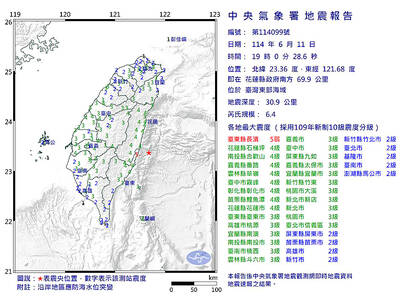Railway industry experts and Keelung residents criticized President Tsai Ing-wen’s (蔡英文) pledge to build a light railway between Taipei and Keelung by 2021, saying that the project is unnecessary and does not address residents’ real needs.
Tsai on Friday announced that the government has earmarked NT$8.1 billion (US$264.48 million) to build a tram-train connecting Keelung Port — which the government aims to turn into a home port for international cruise ships — to Taipei’s Nangang District (南港).
The project would be Taiwan’s first to use tram-trains, which would operate on roads and Taiwan Railways Administration (TRA) tracks, Tsai said
“Keelung residents have been expecting a mass rapid transit [MRT] system for decades and none of the previous administrations could provide it. I want to tell everyone in Keelung that we will definitely deliver it. The Democratic Progressive Party administration has the will and determination to ensure that Keelung gets an MRT,” Tsai said.
Europe’s tram-train systems are often built in remote areas that service a relatively small volume of passengers, Society of Railway and National Planning secretary-general Chen Yen-liang (陳彥良) said.
The TRA’s railway service between Keelung and Nangang is already under pressure because of the frequency of trains, and the project would entail its limited railway line capacity being shared with a light railway system, he said.
“The light railway would only take passengers to Taipei’s MRT Nangang Exhibition Center Station and people would have to change trains at Keelung’s Badu (八堵) train station if they want to go to Taipei Railway Station. It would not even be connected to the high-speed rail system,” Chen said, adding that the proposal is nothing more than a bid to fulfill a campaign promise.
“Rather than building a light railway whose trains run only slightly faster than TRA trains, the government should use the earmarked funds to buy new commuter trains,” he said.
A former Keelung resident surnamed Chang (張), who now lives in New Taipei City’s Sanchung District (三重) and commutes daily between her home and Keelung, said the proposed light railway is unnecessary.
“Keelung does not have a big department store, because people in Keelung go to Taipei to do their shopping,” she said. “Nearly all the buses to Taipei — to the city’s Xinyi District (信義), Chang Kung Memorial Hospital, Hsin Tian Temple, or National Taiwan University — depart from Keelung Railway Station. The buses leave about every 15 minutes during peak hours, making them even more convenient than the inner-city bus system sometimes,” she said.
Keelung has more mountain fortresses built during the Qing Dynasty or the Japanese colonial era than anywhere else in the nation, Chang said.
The government should use the money it wants to spend on the light railway to improve access to these tourist destinations, she said.
A netizen named Liu Po-shen said that not many roads in Keelung have extra space for a light railway line to be built.
“National Sun Yat-sen Freeway [Freeway No. 1] has only two lanes between Keelung and [New Taipei City’s] Sijhih district (汐止), and congestion often occurs at the Wudu (五堵) Interchange because of traffic from Provincial Highway 62. They should extend the overpass between Wugu (五股) and Yangmei (楊梅) on the Sun Yat-Sen Freeway all the way to Keelung,” Liu said.
Keelung residents need railway lines from Keelung Railway Station to be extended to the city’s outlying districts, such as the one from Taipei Railway Station that goes to New Taipei City’s Sindian (新店), netizen Tsai Yi-lin said, adding that residents in most areas of Keelung can get to Taipei faster by bus.

A magnitude 6.4 earthquake struck off the coast of Hualien County in eastern Taiwan at 7pm yesterday, the Central Weather Administration (CWA) said. The epicenter of the temblor was at sea, about 69.9km south of Hualien County Hall, at a depth of 30.9km, it said. There were no immediate reports of damage resulting from the quake. The earthquake’s intensity, which gauges the actual effect of a temblor, was highest in Taitung County’s Changbin Township (長濱), where it measured 5 on Taiwan’s seven-tier intensity scale. The quake also measured an intensity of 4 in Hualien, Nantou, Chiayi, Yunlin, Changhua and Miaoli counties, as well as

STAY AWAY: An official said people should avoid disturbing snakes, as most do not actively attack humans, but would react defensively if threatened Taitung County authorities yesterday urged the public to stay vigilant and avoid disturbing snakes in the wild, following five reported snakebite cases in the county so far this year. Taitung County Fire Department secretary Lin Chien-cheng (林建誠) said two of the cases were in Donghe Township (東河) and involved the Taiwan habus, one person was bit by a Chinese pit viper near the South Link Railway and the remaining two were caused by unidentified snakes. He advised residents near fields to be cautious of snakes hiding in shady indoor areas, especially when entering or leaving their homes at night. In case of a

Credit departments of farmers’ and fishers’ associations blocked a total of more than NT$180 million (US$6.01 million) from being lost to scams last year, National Police Agency (NPA) data showed. The Agricultural Finance Agency (AFA) said last week that staff of farmers’ and fishers’ associations’ credit departments are required to implement fraud prevention measures when they serve clients at the counter. They would ask clients about personal financial management activities whenever they suspect there might be a fraud situation, and would immediately report the incident to local authorities, which would send police officers to the site to help, it said. NPA data showed

ENERGY RESILIENCE: Although Alaska is open for investments, Taiwan is sourcing its gas from the Middle East, and the sea routes carry risks, Ho Cheng-hui said US government officials’ high-profile reception of a Taiwanese representative at the Alaska Sustainable Energy Conference indicated the emergence of an Indo-Pacific energy resilience alliance, an academic said. Presidential Office Secretary-General Pan Men-an (潘孟安) attended the conference in Alaska on Thursday last week at the invitation of the US government. Pan visited oil and gas facilities with senior US officials, including US Secretary of the Interior Doug Burgum, US Secretary of Energy Chris Wright, Alaska Governor Mike Dunleavy and US Senator Daniel Sullivan. Pan attending the conference on behalf of President William Lai (賴清德) shows a significant elevation in diplomatic representation,